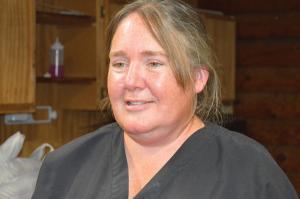By Nancy Brannon, Ph.D.
On a cold, rainy night, over 60 people filled the Eads Civic Center in Eads, Tenn. on Monday November 12, 2018 to hear all about colic from Jennifer Dunlap, DVM. She informed the group about ways to prevent colic, what treatments to pursue if your horse does colic, and what to have on hand for a colic emergency kit. A small supper of pizza and drinks were provided, and the Animal Response Foundation held a bake sale with numerous delicious dessert items.
What exactly is colic? Colic refers to abdominal pain, rather than a specific disorder, usually in the GI tract, but can be in the reproductive tract or urinary tract. Conditions that commonly cause colic include gas, impaction, grain overload, sand ingestion or other nondigestibles, and parasite infection. Of course, to understand digestive disorders, it is first important to understand how your horse’s digestive system works. [That was covered in the MSHR Nov. issue article on Horse Management Field Days.]
Horses are designed to be constant grazers and, thus, constantly secrete digestive acid. Salivation is the first important step to breaking down food, so it’s important to feed hay before feeding concentrates.
The main things to take away for preventing colic in your horses are: (1) always have sufficient clean (not frozen) water for your horse; (2) have adequate forage available for your horse at all (most) times; (3) regular turnout for your horse. In addition, make any changes in diet slowly, avoid riding your horse to exhaustion, and provide adequate shelter. Provide these basic needs for your horse and you greatly reduce the likelihood that your horse will colic.
Another factor is feed. Dunlap recommends that you “buy as high a quality feed as you can afford” and that any changes you make in your horse’s feed program, you do gradually over about a week’s time period. Horses are creatures of habit and so are their digestive systems. They like/need to be fed at the same times every day and fed the same type of food every day. This ensures that the crucial microbiota, or gut flora can properly do their work in the role of digestion and synthesizing certain vitamins.
So, despite all your good care, what if your horse colics? What are the symptoms? As Dr. Dunlap noted, horses have not read the colic symptom guide book! Symptoms can vary greatly from horse to horse, so it’s very important to know your horse’s normal state, including the vital signs of temperature, heart rate, pulse, and respiration rate. This is the baseline from which any behavioral or physical changes are measured.
What’s normal? Normal heart rate is about 28 to 44 beats per minute (bpm). A heart rate over 64 bpm signifies pain. A stethoscope is the easiest means of measuring a horse’s heart rate and Dr. Dunlap recommends having one in your “emergency kit.” Respiration rate is normally 12 – 16, and normal rectal temperature in an adult horse is 98.5 to 101 degrees F, while foals’ can normally be up to 102 degrees F. Dr. Dunlap recommends having a digital rectal thermometer in your kit. Gums should be a light pink color and that color should return within two seconds of pressing with your finger above the teeth and then releasing. This is capillary refill time. Any longer time to return color to the gums or a pale color with a purple flush around the edges indicates a problem.
If you suspect colic, call your veterinarian immediately. Dr. Dunlap says most colics can be successfully handled at the barn. While waiting for the veterinarian, keep your horse contained in a safe area. You can walk your horse to stimulate gut motility and prevent injury from rolling, but Dr. Dunlap says not to overly walk your horse and definitely NOT to the point of exhaustion. If your horse will lie quietly, let him be. Offer the horse water but do not allow the horse access to feed – grain or hay or grass.
Diagnosis of colic begins with a physical exam, checking for intestinal sounds, temperature, pulse, respiration rate, and checking mucous membrane color and capillary refill time. It can also include rectal palpation, nasogastric intubation, abdominal ultrasound, and sometimes blood tests. The sooner a proper diagnosis is made and treatment begins, the more likely a good prognosis and recovery.
Dr. Dunlap says that Banamine is the drug of choice for effective relief of GI pain. But it’s also important to give an appropriate dose and then wait at least 24 hours before giving another – if at all needed, and never in the muscle! If the horse does not appear to respond to that first dose, the condition may be beyond what the drug can alleviate. And, overdosing can lead to more problems, like gastric ulceration, colitis, and renal problems.
Dr. Dunlap went into detail about the types of colic, such as gas/spasmodic; obstruction; stomach ulcers; enteritis (inflammation of the small intestine); colitis (inflammation of the large colon); displacement; and strangulation.
There was much more detail that space here allows, so you won’t want to miss Dr. Dunlap’s next presentation. It will be on Respiratory Disease, February 11, 2019 at the Eads Civic Center, 12365 Washington Street in Eads, Tenn.
On a cold, rainy night, over 60 people filled the Eads Civic Center in Eads, Tenn. on Monday November 12, 2018 to hear all about colic from Jennifer Dunlap, DVM. She informed the group about ways to prevent colic, what treatments to pursue if your horse does colic, and what to have on hand for a colic emergency kit. A small supper of pizza and drinks were provided, and the Animal Response Foundation held a bake sale with numerous delicious dessert items.
What exactly is colic? Colic refers to abdominal pain, rather than a specific disorder, usually in the GI tract, but can be in the reproductive tract or urinary tract. Conditions that commonly cause colic include gas, impaction, grain overload, sand ingestion or other nondigestibles, and parasite infection. Of course, to understand digestive disorders, it is first important to understand how your horse’s digestive system works. [That was covered in the MSHR Nov. issue article on Horse Management Field Days.]
Horses are designed to be constant grazers and, thus, constantly secrete digestive acid. Salivation is the first important step to breaking down food, so it’s important to feed hay before feeding concentrates.
The main things to take away for preventing colic in your horses are: (1) always have sufficient clean (not frozen) water for your horse; (2) have adequate forage available for your horse at all (most) times; (3) regular turnout for your horse. In addition, make any changes in diet slowly, avoid riding your horse to exhaustion, and provide adequate shelter. Provide these basic needs for your horse and you greatly reduce the likelihood that your horse will colic.
Another factor is feed. Dunlap recommends that you “buy as high a quality feed as you can afford” and that any changes you make in your horse’s feed program, you do gradually over about a week’s time period. Horses are creatures of habit and so are their digestive systems. They like/need to be fed at the same times every day and fed the same type of food every day. This ensures that the crucial microbiota, or gut flora can properly do their work in the role of digestion and synthesizing certain vitamins.
So, despite all your good care, what if your horse colics? What are the symptoms? As Dr. Dunlap noted, horses have not read the colic symptom guide book! Symptoms can vary greatly from horse to horse, so it’s very important to know your horse’s normal state, including the vital signs of temperature, heart rate, pulse, and respiration rate. This is the baseline from which any behavioral or physical changes are measured.
What’s normal? Normal heart rate is about 28 to 44 beats per minute (bpm). A heart rate over 64 bpm signifies pain. A stethoscope is the easiest means of measuring a horse’s heart rate and Dr. Dunlap recommends having one in your “emergency kit.” Respiration rate is normally 12 – 16, and normal rectal temperature in an adult horse is 98.5 to 101 degrees F, while foals’ can normally be up to 102 degrees F. Dr. Dunlap recommends having a digital rectal thermometer in your kit. Gums should be a light pink color and that color should return within two seconds of pressing with your finger above the teeth and then releasing. This is capillary refill time. Any longer time to return color to the gums or a pale color with a purple flush around the edges indicates a problem.
If you suspect colic, call your veterinarian immediately. Dr. Dunlap says most colics can be successfully handled at the barn. While waiting for the veterinarian, keep your horse contained in a safe area. You can walk your horse to stimulate gut motility and prevent injury from rolling, but Dr. Dunlap says not to overly walk your horse and definitely NOT to the point of exhaustion. If your horse will lie quietly, let him be. Offer the horse water but do not allow the horse access to feed – grain or hay or grass.
Diagnosis of colic begins with a physical exam, checking for intestinal sounds, temperature, pulse, respiration rate, and checking mucous membrane color and capillary refill time. It can also include rectal palpation, nasogastric intubation, abdominal ultrasound, and sometimes blood tests. The sooner a proper diagnosis is made and treatment begins, the more likely a good prognosis and recovery.
Dr. Dunlap says that Banamine is the drug of choice for effective relief of GI pain. But it’s also important to give an appropriate dose and then wait at least 24 hours before giving another – if at all needed, and never in the muscle! If the horse does not appear to respond to that first dose, the condition may be beyond what the drug can alleviate. And, overdosing can lead to more problems, like gastric ulceration, colitis, and renal problems.
Dr. Dunlap went into detail about the types of colic, such as gas/spasmodic; obstruction; stomach ulcers; enteritis (inflammation of the small intestine); colitis (inflammation of the large colon); displacement; and strangulation.
There was much more detail that space here allows, so you won’t want to miss Dr. Dunlap’s next presentation. It will be on Respiratory Disease, February 11, 2019 at the Eads Civic Center, 12365 Washington Street in Eads, Tenn.









